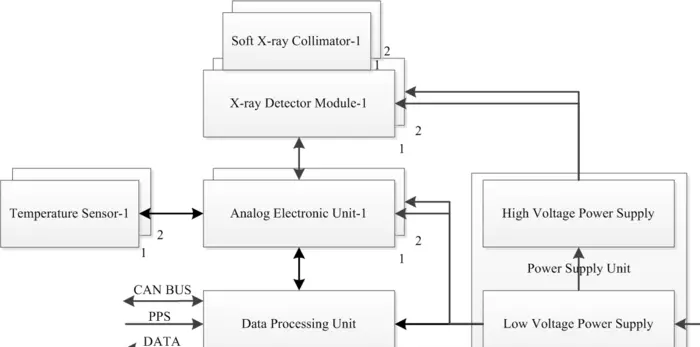Researchers at the Beijing Institute of Control Engineering, together with their counterparts from Northwestern Polytechnical University and Macau University of Science and Technology, have made a groundbreaking advancement in the realm of solar observation with the development of a new solar X-ray detector (SXD). This innovative detector has been engineered to operate effectively within a broad energy range and achieve high count rates, which are essential for studying the intricate spectral characteristics of solar flare eruptions. The underlying objective of this revolutionary instrument is to provide detailed insights into the phenomena that accompany solar flares, which are among the most energetic events in the solar system.
The SXD is significant not only due to its advanced design but also because it has been successfully integrated on the Macao Science Satellite-1B (MSS-1B). Since its launch, this detector has exhibited remarkable in-orbit performance, achieving a notable energy resolution of 138 eV during solar X-ray sensing operations. This accomplishment underscores the detector’s capacity to provide highly accurate measurements, which are critical for understanding the dynamics of solar flares.
A focal point in the design of the SXD is its reliance on a sophisticated electronic architecture that caters specifically to the stringent demands of space missions. This meticulous planning ensures that the detector remains reliable and functional even amidst the extreme conditions that characterize intense solar events, including those classified as X-class flares. Comparative analyses with existing solar X-ray instruments illustrate how the SXD surpasses its predecessors by providing enhanced energy resolution and minimized signal peaking times, thereby allowing it to capture solar flare signals at unprecedented levels.
Operational excellence is achieved through strategic design in the SXD’s components. Its configuration includes multiple X-ray Detector Modules (XDMs), analog electronic units (AEUs), and a centralized data processing unit (DPU), along with a power supply unit (PSU). The thoughtful arrangement of these components features collimators that serve to narrow the field of view and enhance sensitivity. This intricate architecture not only boosts the performance of the instrument but also aids in achieving higher count rates that are vital for capturing fluctuating solar activity effectively.
Moreover, advancements in noise reduction techniques have allowed the SXD to function at an impressive input count rate of more than 1 million counts per second. The choice of using a silicon drift detector (SDD) as the X-ray sensor is a key component in this achievement. The unique design of the SDD with its low capacitance plays a crucial role in facilitating short peaking times, directly correlating to an increase in the detector’s count rate. The integration of thermoelectric cooling technology further enhances the device by improving energy resolution, ensuring that measurements fall within the desired parameters even under challenging thermal conditions.
The capabilities of the SXD allow it to process data with a time cadence optimized to one second, a significant enhancement compared to previous models. This rapid processing enables the instrument to deliver valuable insights during solar flare events, which are classified based on their X-ray brightness metrics on a logarithmic scale. Fine-tuning of shaping amplifier peaking times has showcased an innovative approach to signal processing, ensuring that the SXD maintains clarity and precision even amid the complexities of solar emissions.
In practice, the SXD has been instrumental in capturing solar flares reaching the X-class level, marking it as a record-setting achievement for instruments operated from Earth’s orbit. The observational data retrieved from the SXD is rich with detailed information about the solar X-ray spectrum, which typically presents a sharply decreasing continuum as energy increases. This characteristic data aids researchers in assessing the physical properties of solar emissions, including the ionization states of various elements such as calcium, iron, and argon.
Furthermore, the SXD contributes significantly to the temporal analysis of plasma diagnostics. With its capability to precisely monitor changes in temperature, emission measure, and elemental abundances, the detector provides a comprehensive understanding of the thermal plasma dynamics during solar flares. These insights are vital for enhancing scientific models that predict solar behavior and assess the potential impacts of solar activity on Earth, particularly in relation to satellite communications and power systems.
The successful launch of the MSS-1B on May 21, 2023, not only heralded a new chapter in solar observation but also set the stage for a series of ongoing studies centered around solar flares. The data being collected by the SXD contributes to an expanding pool of research that is poised to redefine our understanding of solar phenomena. The findings from this instrument are expected to play a pivotal role in shaping future research and exploration in astrophysics and space weather prediction.
In summary, the development of the solar X-ray detector signifies a remarkable stride toward deeper comprehension of solar activities and their implications. With its innovative electronic architecture, exceptional resolution, and rapid operational capabilities, the SXD on the MSS-1B represents not only a technological achievement but also a vital tool for advancing knowledge in space science. This research underscores the transformative power of technology in unraveling the mysteries of our sun and opens new avenues for astrophysical exploration.
As ongoing studies and analyses continue to exploit the SXD’s capabilities, there is significant anticipation surrounding the implications of this research for both theoretical models and practical applications in astronomy and solar physics.
Subject of Research: Not applicable
Article Title: Low-noise read-out electronics design for a solar soft X-ray spectrometer onboard the MSS-1B satellite
News Publication Date: 9-May-2025
Web References: http://dx.doi.org/10.1007/s41365-025-01699-z
References: 10.1007/s41365-025-01699-z
Image Credits: Jian-Wu Chen




